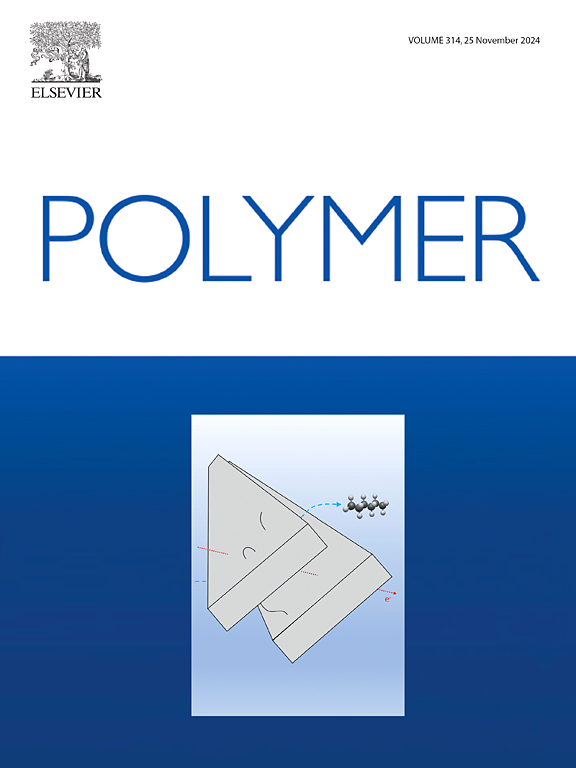Hygrothermal and corrosive effects on mechanical response and fatigue driven cracking behavior of perfluorosulfonic acid ionomer
IF 4.5
2区 化学
Q2 POLYMER SCIENCE
引用次数: 0
Abstract
Perfluorosulfonic acid (PFSA) ionomers is one of the most crucial materials for ion-conductive membrane, however, the fatigue driven failure behavior especially under hygrothermal and corrosive environments remain unclear. Herein, the effects of multiple factors including strain rate, temperature, humidity and chemical attack on the constitutive response and fatigue behavior of PFSA ionomers were investigated using multiple in-situ testing means with monotonic tension and fatigue crack propagation. The results demonstrate that under high hygrothermal conditions, PFSA ionomer exhibit a decrease in strength and stress relaxation resistance accompanied by increased ductility, with enhanced temperature sensitivity, while nonlinear accumulation of damaged side chains and backbone with corrosion time results in increased brittleness and rigidity after chemical corrosion. Increases in both stress ratio and hygrothermal conditions promote crack propagation, whereas higher loading frequencies inhibit it, and following 72 h of corrosion, the crack propagation rate exhibits a two order of magnitude increase. Under high hygrothermal conditions, fracture surface ligaments exhibit more pronounced serration features and develop a tendency to curl and elongate, while following chemical corrosion, teardrop-shaped pore morphologies emerge in the crack nucleation region, and circumferential slender ligaments develop in the advanced stages of crack propagation. Based on these results, a fatigue joint damage mechanism of PFSA ionomer under the combined effects of hygrothermal conditions and chemical corrosion is proposed.


湿热和腐蚀对全氟磺酸离聚体力学响应和疲劳开裂行为的影响
全氟磺酸(PFSA)离聚体是离子导电膜的关键材料之一,但其在高温和腐蚀环境下的疲劳破坏行为尚不清楚。采用单调拉伸和疲劳裂纹扩展的多种原位试验手段,研究了应变速率、温度、湿度和化学侵蚀等多种因素对PFSA离子单体本构响应和疲劳行为的影响。结果表明:在高湿热条件下,PFSA离子聚体的强度和抗应力松弛性降低,延性增加,温度敏感性增强,而损伤侧链和主链随腐蚀时间的非线性积累导致化学腐蚀后脆性和刚度增加。应力比和湿热条件的增加都促进了裂纹扩展,而较高的加载频率则抑制了裂纹扩展,并且在腐蚀72 h后,裂纹扩展速率增加了两个数量级。在高湿热条件下,断口表面的韧带呈现出更为明显的锯齿状特征,并有卷曲和伸长的趋势,而在化学腐蚀后,裂纹成核区出现泪滴状孔隙形态,在裂纹扩展的后期阶段形成环状细长韧带。在此基础上,提出了PFSA离子单体在湿热条件和化学腐蚀共同作用下的疲劳接头损伤机理。
本文章由计算机程序翻译,如有差异,请以英文原文为准。
求助全文
约1分钟内获得全文
求助全文
来源期刊

Polymer
化学-高分子科学
CiteScore
7.90
自引率
8.70%
发文量
959
审稿时长
32 days
期刊介绍:
Polymer is an interdisciplinary journal dedicated to publishing innovative and significant advances in Polymer Physics, Chemistry and Technology. We welcome submissions on polymer hybrids, nanocomposites, characterisation and self-assembly. Polymer also publishes work on the technological application of polymers in energy and optoelectronics.
The main scope is covered but not limited to the following core areas:
Polymer Materials
Nanocomposites and hybrid nanomaterials
Polymer blends, films, fibres, networks and porous materials
Physical Characterization
Characterisation, modelling and simulation* of molecular and materials properties in bulk, solution, and thin films
Polymer Engineering
Advanced multiscale processing methods
Polymer Synthesis, Modification and Self-assembly
Including designer polymer architectures, mechanisms and kinetics, and supramolecular polymerization
Technological Applications
Polymers for energy generation and storage
Polymer membranes for separation technology
Polymers for opto- and microelectronics.
 求助内容:
求助内容: 应助结果提醒方式:
应助结果提醒方式:


